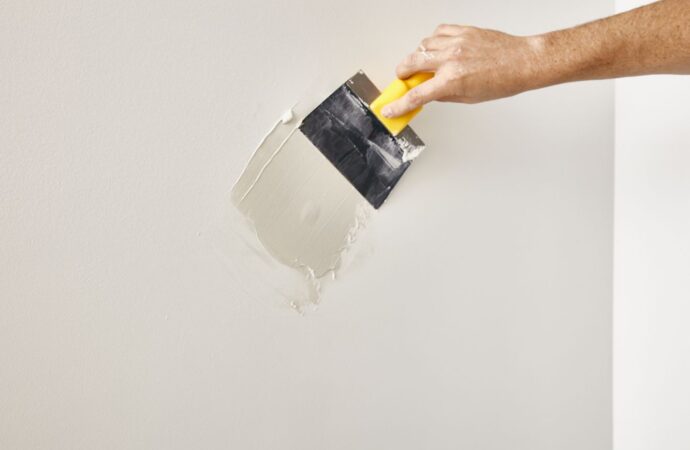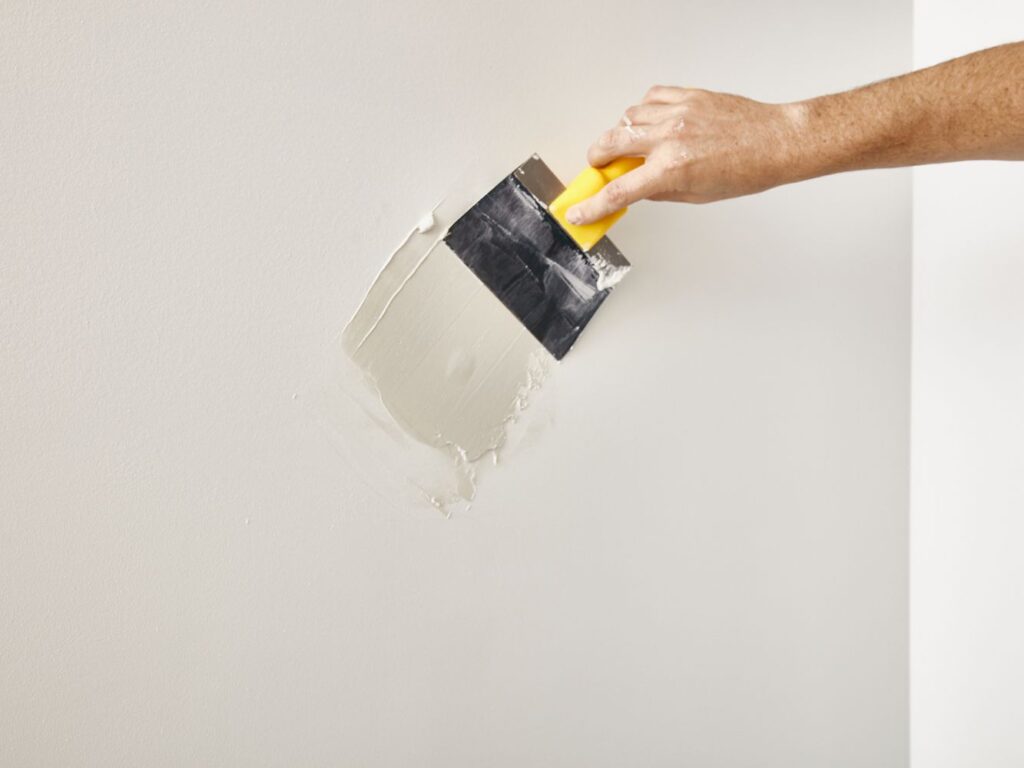Paying attention to walls is an essential aspect of home improvement. The walls can make or break the atmosphere of a room. There are many ways to decorate walls in your home. Drywall texture gives you so many creative options for your home. Drywall repair adds character and depth to walls, making your rooms appear fantastic. Drywall texture has many practical applications, as well as its aesthetic appeal. Wall imperfections can be concealed, and plastering and sandpapering are avoided. You can use spray applications, slap brush texture using plaster, and Venetian plaster texturing to hide wall imperfections. The process usually only requires one coat. Priming, brushing, and texturing are the three main steps in this process. Each step is vital to the final result. The Slap Brush Texture is one of the most popular Drywall Texture methods. The plaster is then diluted with water, sprayed with a texture sprayer, or applied with the nap roller. To create the slap effect, a stipple brush is used. For the stipple effect, press the meeting into Drywall Texture. Pull away from the Drywall Texture. It can be challenging to repair cracked drywall seams. If there is a small crack, you may be able to make it larger and then apply the spackling compound. Use a pointed, sharp tool like a church key or old-fashioned can opener to create a groove slightly wider than the crack. The track should be at least 1/8 inch deep, but it can go deeper. Although many patching compounds can be used to repair cracks, they are not designed for large areas. You will need to sand the wall if you are painting it. A smooth, painted surface will not allow spackle to stick to it. Sand the crack area at least 2 inches wide. Next, apply the patching compound to the crack. Make sure that you press the spackle into the crack. After applying the spackle to the crack, use your knife to re-wipe it. This will remove any spackle that may have accumulated and create a flat surface. The drying time varies depending on the type of compound that you have purchased. Use 120 or 100 grit drywall paper to smoothen the area until it is flush with your wall. Prime the drywall before applying the final paint. Large cracks along seams may be caused by drywall tape pulling off, physical damage, or excess moisture. Remove all taped materials. It is not possible to spackle old tape. The holes in drywall tape allow the spackle to pass through the tape and attach it to your seams. The spackle “wets” the tape, allowing it to stick to the wall and forming a bond with the spackle. The tape is useless once it has been used. The seam will crack if you try to cut corners. After taking out all debris, sand lightly the areas that are damaged. Be careful not to damage or sand through any drywall paper layers. You should make sure that the entire area is smooth and even. This will prevent any edges from showing through the finished product. Install a thin layer of spackle on the seam using a 6-inch-wide spackle knife. Apply your new drywall tape to the seam. The knife will push the tape down onto the drywall, removing any excess spackle that may have escaped from the sides and under the tape. Don’t remove too much spackle to allow the paper to dry. After the area has been smoothed, apply another lighter coat to the same area. Make sure that the new tape is fully embedded in the spackle. To ensure that all spackle has dried, dry the area for one day. Then sand the whole area again to get a smooth finish. Spread a second coat of spackle onto the entire area using your 12-inch knife. Make sure it blends seamlessly into the wall surfaces. Don’t leave sharp edges or ridges where you meet the wall finish. Apply a thin third coat of spackle to the surface after the second coat is dry. This will take longer than the base coat because it is more delicate. This coat fills in minor scratches or indentions left from the previous coat. After the third coat has dried, lightly sand the area to ensure a smooth finish. To seal the newly repaired drywall area, apply drywall primer and then paint your wall. The drywall seams may have cracked or been split open. This could indicate a structural problem. You should first address foundation issues, building settlement, and other factors affecting drywall finishes. After you have made sure that there are no other issues, such as a minor repair or a primary replacement, take out any damaged or loose materials. If the drywall is damaged, you can cut it back to the studs and then install new drywall. You can repair a minor crack on a larger scale. Butt joints are small pieces of drywall that are used for patching. They are difficult to conceal. You will need to spread the spackle across a larger area to achieve a smooth ceiling finish. This simple task can be done with practice and will save you a lot of money. Durobond 90, a quick-drying material that can be added to spackle and makes it rock hard in just ninety seconds, is a good option if you need to repair it quickly. A forty-five-minute version is also available, but professionals should only use this. It takes only 45 minutes, which is a lot. It dries very hard, so it’s almost impossible to sand once dried. Any minor imperfections left by your knife will be visible later. Be careful. Keep your tools clean. Don’t open lids or cans with knives. This will damage or chip the edges. No matter how old the house is or how diligent you are about maintaining it, drywall ceiling repairs will be required at some point in your home. It is essential to plan and know your options when you need to repair them. Repairs can be made for small cracks up to medium-sized holes or large areas of damaged drywall due to water damage or other destruction. Below are some options for repairing your drywall ceiling. The most common method of repairing drywall ceilings is to call in Port St Lucie Popcorn Ceiling Removal & Drywall Repair Pros. They will not need your assistance and can complete the job in a short time. This is an option if you don’t have the skills or time to do the work yourself. This is your best option if you’re unsure and can afford the bill. You can repair the ceiling yourself, but it is better to seek the guidance and advice of someone with experience with these repairs. You can ask a neighbor with the necessary skills to help you with the repairs. These people can guide you in the drywall ceiling repair and the correct texture after the repair has been completed. It may not be challenging to repair a crack in your ceiling if it is small. You can find drywall ceiling repair kits in most home improvement stores. These kits will walk you through each step of the process. You will only need to fill the area in mud or putty for minor repairs. Then, flatten the surface and let it dry. You can mask the damage by filling the crack with the compound. Larger jobs may require the replacement of entire sheets or a portion of a sheet. It is essential to be familiar with the process of repairing drywall ceilings. You can use a guide to help you do the job yourself or hire a professional. Removing the drywall and attaching a new piece to the area will be necessary. You may need additional help to install new drywall. Homeowners can repair drywall ceilings if there isn’t too much damage. If you have significant damage to your ceiling, it may be necessary to hire a professional. The info provided here can help you decide what action to take if you need to repair your ceiling. Making a hole in your drywall is easy if you have a home. It is easy to repair drywall, even smaller holes. This is good news for novice homeowners. It is better to replace the whole sheet of drywall than create a patch if the hole is huge (12 inches or more). Here are some suggestions for fixing any other holes in your drywall: Repairing holes Traditionally, when you needed to repair a hole in your drywall, a contractor would attempt to square it up as best as possible. Then, they would put in wooden braces that would support a new square. Aluminum patches have been created that can be used to cover the hole. Aluminum patches are strong enough to cover larger holes and thin enough to be covered with thin spackle. The aluminum patches work in the same manner as traditional drywall tape. You apply a thin layer of spackle to the mesh and let it dry. The next day, you can add another coat using a larger trowel. Some people suggest sanding between coats, while others recommend that you sand only after the second coat. Cracks can often develop when a house settles. It is common to see cracks in drywall both in new and older homes. This is a simple fix. Use a knife or razor blade to create a channel that runs along the crack. Apply joint compound or spackle to the crack, then a mesh tape to cover it. (While the aluminum patch is excellent for small holes, a regular mesh tape is better for this purpose). After applying the mesh tape, feather the ends with a spackle. Once it has dried, feather it again. (If necessary, a third). Sand it to a smooth finish before it dries. Filling in holes and nail holes that have been left from photos or fixtures attached to walls is the most common repair. Vibrations can cause screws or nails to loosen. Another easy way to fix this is to use a trowel or screwdriver. To create a crater, use the end of a screwdriver or trowel to tap into the holes. You can attach or nail a new fastener to the hole if the drywall is not tight enough. Use spackle to fill the hole. Sand the surface once it has dried. Metal corner beads were used in modern homes to finish the corners. Although it creates a crisp hub, it is easy to dent. It can be bent back to shape using a few soft taps and a hammer. After you have hammered the wall back to shape, look for cracks in the metal bead. You will need to cover any damages with mesh tape. After you have taped it, apply the spackle to the area. Please wait for it to dry, then start again. After you have taped the room, use the spackle to smoothen it. We offer the above services at the following locations within Port St Lucie:
If you are located in Palm Beach County and you don’t see your city/area listed above, don’t worry! We cover all of Palm Beach County. Fill out the contact form above or CLICK HERE and send us a message. We’ll get back to you asap!
Drywall Repair
Contact Us

Get in touch with a professional
Get detailed advice and guidance.
Kits to Do it yourself for minor repairs
Large Patching Options

Repairing Cracks
Repairing Screw and Nail Holes
Repairing Corners
Locations We Serve

